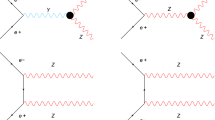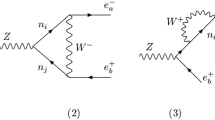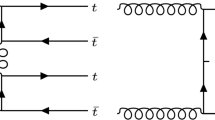Abstract
In view of the discovery of a new boson by the ATLAS and CMS Collaborations at the LHC, we present an update of the global Standard Model (SM) fit to electroweak precision data. Assuming the new particle to be the SM Higgs boson, all fundamental parameters of the SM are known allowing, for the first time, to overconstrain the SM at the electroweak scale and assert its validity. Including the effects of radiative corrections and the experimental and theoretical uncertainties, the global fit exhibits a p-value of 0.07. The mass measurements by ATLAS and CMS agree within 1.3σ with the indirect determination \(M_{H}=94^{\,+25}_{\,-22}~\mathrm{GeV}\). Within the SM the W boson mass and the effective weak mixing angle can be accurately predicted to be M W =80.359±0.011 GeV and \(\sin ^{2}\theta ^{\ell }_{{\rm eff}}= 0.23150\pm 0.00010\) from the global fit. These results are compatible with, and exceed in precision, the direct measurements. For the indirect determination of the top quark mass we find \(m_{t}= 175.8^{\:+2.7}_{\:-2.4}~ \mathrm {GeV}\), in agreement with the kinematic and cross-section-based measurements.





Similar content being viewed by others
Notes
The theoretical uncertainties arising from nonperturbative color-reconnection effects in the fragmentation process [13, 14], and from ambiguities in the top-mass definition [15, 16], affect the (kinematic) top-mass measurement. Their quantitative estimate is difficult and may reach roughly 0.5 GeV each, where the systematic error due to shower effects could be larger [13]. To estimate the effect of a theoretical uncertainty of 0.5 GeV, inserted in the fit as a uniform likelihood function according to the Rfit scheme [17, 18], we have repeated the indirect determination of some of the most relevant observables. We find in particular \(M_{H}=90^{\,+34}_{\,-21}~ \mathrm {GeV}\), M W =80.359±0.013 GeV, and \(\sin ^{2}\theta ^{\ell }_{{\rm eff}}=0.23148 \pm0.00010\), which, compared to the standard results given in Eqs. (1), (2) and (3), exhibit only a small deterioration in precision.
The main source of systematic uncertainty in the ATLAS and CMS mass measurements stems from the energy and momentum calibrations, which should be uncorrelated between the experiments.
The quantity of \(R^{0}_{b}\) has only little dependence on M H [25].
For the indirect determination of \(\sin ^{2}\theta ^{\ell }_{{\rm eff}}\), shown as the blue band in Fig. 3 (bottom right), we exclude from the fit all experimental measurements with direct sensitivity to \(\sin ^{2}\theta ^{\ell }_{{\rm eff}}\), namely the measurements of Γ Z , \(\sigma_{\rm had}^{0}\), \(R^{0}_{\ell }\), \(A_{\rm FB}^{0,\ell }\), A ℓ , \(\sin ^{2}\theta ^{\ell }_{{\rm eff}}(Q_{\rm FB})\), A c , A b , \(A_{\rm FB}^{0,c}\), \(A_{\rm FB}^{0,b}\), \(R^{0}_{c}\) and \(R^{0}_{b}\). As a compensation of the missing value of \(R^{0}_{\ell }\) we provide a value for \(\alpha _{\scriptscriptstyle S}(M_{Z}^{2})\). Since the fit results are independent of the exact \(\alpha _{\scriptscriptstyle S}\) value, we use our fit result 0.1191±0.0028 in this case.
We show the aforementioned result of the Tevatron combination of the direct top-mass measurements [12], the top pole mass derived from the measured \(t\bar{t}\) cross section at the Tevatron (m t =173.3±2.8 GeV), assuming no new physics contributes to this cross-section measurement [32], the direct top-mass measurement of ATLAS determined in 1.04 fb−1 of pp collisions at \(\sqrt{s}=7~\mathrm{TeV}\) (m t =174.5±2.4 GeV) [33], the direct top-mass measurement of CMS based on 5.0 fb−1 of 7 TeV data (m t =173.5±1.1 GeV) [34], the aforementioned W mass world average [10] and the LEP/SLD average of the effective weak mixing angle (\(\sin ^{2}\theta ^{\ell }_{{\rm eff}}=0.23153 \pm0.00016\)) [9].
For \(\alpha _{\scriptscriptstyle S}(M_{Z}^{2})\) we use the result from Table 1.
References
ATLAS Collaboration, Phys. Lett. B (2012). 1207.7214
CMS Collaboration, Phys. Lett. B (2012). 1207.7235
ALEPH Collaboration, CDF Collaboration, D0 Collaboration, DELPHI Collaboration, L3 Collaboration, OPAL Collaboration, SLD Collaboration, LEP Electroweak Working Group, Tevatron Electroweak Working Group, SLD Electroweak and Heavy Flavour Groups, 1012.2367
LEP Electroweak Working Group (LEP EWWG), http://lepewwg.web.cern.ch/LEPEWWG
J. Erler, P. Langacker, Phys. Rev. D 86, 010001 (2012) (in: Review for Particle Data Group)
M. Baak et al., Eur. Phys. J. C 72, 2003 (2012). 1107.0975
H. Flacher et al., Eur. Phys. J. C 60, 543 (2009). Erratum-ibid. C 71, 1718 (2011). 0811.0009
O. Eberhardt et al., 1209.1101
The ALEPH, DELPHI, L3, OPAL, SLD Collaborations, the LEP Electroweak Working Group, the SLD Electroweak and Heavy Flavour Working Groups, Phys. Rep. 427, 257 (2006). hep-ex/0509008
CDF Collaboration, D0 Collaboration, T. E. W. Group, 1204.0042
CDF Collaboration, D0 Collaboration, T. E. W. Group, 1003.2826
T. Aaltonen et al. (CDF Collaboration, D0 Collaboration), 1207.1069
P. Skands, D. Wicke, Eur. Phys. J. C 52, 133 (2007). hep-ph/0703081
D. Wicke, P.Z. Skands, Nuovo Cimento B 123, S1 (2008). 0807.3248
A.H. Hoang, A. Jain, I. Scimemi, I.W. Stewart, Phys. Rev. Lett. 101, 151602 (2008). 0803.4214
A.H. Hoang, I.W. Stewart, Nucl. Phys. Proc. Suppl. 185, 220 (2008). 0808.0222
A. Hoecker, H. Lacker, S. Laplace, F. Le Diberder, Eur. Phys. J. C 21, 225 (2001). hep-ph/0104062
J. Charles et al. (CKMfitter Group), Eur. Phys. J. C 41, 1 (2005). hep-ph/0406184
M. Davier, A. Hoecker, B. Malaescu, Z. Zhang, Eur. Phys. J. C 71, 1515 (2011). 1010.4180
P. Baikov, K. Chetyrkin, J.H. Kuhn, Phys. Rev. Lett. 101, 012002 (2008). 0801.1821
P. Baikov, K. Chetyrkin, J. Kuhn, J. Rittinger, Phys. Rev. Lett. 108, 222003 (2012). 1201.5804
M. Awramik, M. Czakon, A. Freitas, G. Weiglein, Phys. Rev. D 69, 053006 (2004). hep-ph/0311148
M. Awramik, M. Czakon, A. Freitas, J. High Energy Phys. 0611, 048 (2006). hep-ph/0608099
M. Awramik, M. Czakon, A. Freitas, G. Weiglein, Phys. Rev. Lett. 93, 201805 (2004). hep-ph/0407317
A. Freitas, Y.-C. Huang, J. High Energy Phys. 1208, 050 (2012). 1205.0299
K. Hagiwara, S. Matsumoto, D. Haidt, C. Kim, Z. Phys. C 64, 559 (1994). Order of authors changed in journal. hep-ph/9409380
K. Hagiwara, Annu. Rev. Nucl. Part. Sci. 48, 463 (1998)
G.-C. Cho, K. Hagiwara, Nucl. Phys. B 574, 623 (2000). hep-ph/9912260
G.-C. Cho, K. Hagiwara, Y. Matsumoto, D. Nomura, J. High Energy Phys. 1111, 068 (2011). 1104.1769
A.B. Arbuzov et al., Comput. Phys. Commun. 174, 728 (2006). hep-ph/0507146
D.Y. Bardin et al., Comput. Phys. Commun. 133, 229 (2001). hep-ph/9908433
S. Alekhin, A. Djouadi, S. Moch, Phys. Lett. B 716, 214 (2012). 1207.0980
G. Aad et al. (ATLAS Collaboration), Eur. Phys. J. C 72, 2046 (2012). 1203.5755
S. Chatrchyan et al. (CMS Collaboration), 1209.2319
M.E. Peskin, T. Takeuchi, Phys. Rev. Lett. 65, 964 (1990)
M.E. Peskin, T. Takeuchi, Phys. Rev. D 46, 381 (1992)
Acknowledgements
We thank Louis Fayard whose questions have triggered the more detailed error analysis for the M W and \(\sin ^{2}\theta ^{\ell }_{{\rm eff}}\) predictions provided in this version of the paper.
Author information
Authors and Affiliations
Consortia
Corresponding author
Rights and permissions
About this article
Cite this article
The Gfitter Group., Baak, M., Goebel, M. et al. The electroweak fit of the standard model after the discovery of a new boson at the LHC. Eur. Phys. J. C 72, 2205 (2012). https://doi.org/10.1140/epjc/s10052-012-2205-9
Received:
Revised:
Published:
DOI: https://doi.org/10.1140/epjc/s10052-012-2205-9




